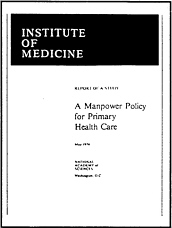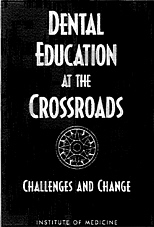Institute of Medicine Reports on the Health Work Force
by Marilyn J. Field, Ph.D.
Deputy Director, Division of Health Care Services, Institute of Medicine
When the Institute of Medicine (IOM) first established program principles and directions, it identified “education in the health professions and distribution of personnel among fields and specialties” as one of six primary areas of concern. The Committee on Education in the Health Professions was one of three overview committees created in 1972.
Since 1970, the IOM has undertaken over a dozen studies of the health care work force (listed at the end of this chapter). These studies have been diverse in subject matter, scope, and approach. The major emphases include
-
general education and work force policies,
-
educational preparation of the health work force, and
-
issues and policies related to specific professions.
Many of the reports necessarily focus on more than one of these broad topics, especially those examining specific professions such as nursing or dentistry. In addition, a number of IOM studies of other topics have discussed how health professions education and work force policies are relevant to their conceres and recommendations. For example, studies of such topics as the future of public health and the development and implementation of clinical practice guidelines have discussed the need for supportive health professions education.
Several IOM studies of educational and work force issues have been congressionally requested, and federal agencies have also supported a number of other studies. Private foundations have been particularly instrumental in studies of the primary care work force (the Robert Wood Johnson and Kellogg Foundations), the representation of minorities in the health professions (the Josiah Macy, Robert Wood Johnson, and Pew Foundations), and the future of dental education (the Robert Wood Johnson Foundation).
POLICIES AFFECTING THE SIZE AND COMPOSITION OF THE HEALTH WORK FORCE
A number of IOM studies have examined the size, composition, and distribution of the health professions and health research work force. Particularly notable are a series of studies, conducted by the National Research Council (NRC) or the IOM, on national needs for biomedical and behavioral science research personnel. The National Research Service Awards (NRSA) Act of 1974 requested the reports to guide decisions about the level and distribution of federal research training awards. A novel element of the 1974 act was that training awards were to be restricted to areas in which the NRC committee determined shortages of research personnel existed (NRC, 1975).
The NRC issued six reports between 1975 and 1981 (Personnel Needsand Training for Biomedical and Behavioral Research). These were followed by IOM reports in 1983 and 1985, and then by NRC reports in 1989 and 1994. The core areas of focus for this series of reports have been the biomedical, clinical, and behavioral sciences, and health services research. Nursing research was added in the late 1970s as a result of legislative changes. Oral health research was explicitly addressed in 1985 and 1994, although earlier reports referred to research training needs in a number of specific clinical areas including dentistry. While under the aegis of the IOM, the study committee also undertook a detailed analysis of the career achievements of National Institutes of Health (NIH) supported predoctoral trainees and fellows and an analysis of NIH postdoctoral fellows.
The 1994 NRC report Meeting the Nation's Needs for Biomedical andBehavioral Scientists made recommendations regarding the number of NRSA predoctoral and postdoctoral training grants and fellowships that should be funded in several areas and called for higher stipends and a better system to track program graduates. The report also devoted a chapter to a review and critique of models of supply and demand used by previous NRSA study committees, and the panel responsible for that chapter is continuing its exploration of demographic techniques for estimating future supply. The reports have also analyzed the problems of projecting future need or demand
for researchers given the unpredictability of scientific and technological advances, economic forces, and public policy directions.
Although its title, Medicare and Medicaid Reimbursement, does not suggest it, this 1976 IOM report focused primarily on the relation between physician payment policies for teaching hospitals and the training and supply of medical personnel. This study included a national survey of 1,400 teaching hospitals and detailed studies of 96 of those institutions. It reiterated concerns that the country was oversupplied with surgeons and undersupplied with primary contact physicians and that Medicare policies contributed to this imbalance. It emphasized the complexity of fitting payment policies to multiple policy objectives (e.g., reasonable payment for patient services and appropriate support for medical education) and stressed the need for experimentation with innovative per capita, per case, and other payment strategies tailored for teaching hospitals. The report did not examine the relation between medical education policies and an emerging federal policy of support for capitated health plans serving defined populations (e.g., HMOs; see Health Maintenance Organizations: Toward a Fair Market Test, 1974), but the analysis foreshadows the problem of aligning these policy concerns.
Some of the themes of Medicare and Medicaid Reimbursement were sounded again in a 1978 report, A Manpower Policy for Primary Health Care. This report focused on growing concerns about the balance between primary and specialty health care. One of the significant products of the study was a definition of primary care, which has been widely used and credited with focusing attention on the content of primary care rather than on the categorization of practitioners. An IOM study on the future of primary care currently under way continues this orientation. This report is scheduled to be released early in 1996.

In addition to primary care and specialist physicians, recommendations in the 1978 report on manpower covered nurse practitioners and physician assistants, then relatively new personnel categories. The study committee explicitly stated that it could not support continued policies to increase medical school enrollments. Moreover, because of the projected increase in the number of physicians that existing policies would generate, the committee also recommended no further increase in numbers of nurse practitioners and physician assistants. It recommended against differential payments for primary and nonprimary care services, against different payment levels for primary services depending on whether they were provided by physicians or other practitioners, and against geographic differentials in physician payment levels. Debate continued over these issues in the 1980s,
both before and after the 1986 legislation (P.L. 99-272) instituted to reform Medicare's methods for paying physicians.
In the 1980s, the Veterans Administration (VA) (now the Department of Veterans Affairs) asked the IOM to develop “a methodology for estimating the number of physicians, by specialty groupings, required for the efficient delivery of high-quality physician services in all programs and facilities operated by the VA” (Physician Staffing for the VA, 1991). Assisted by 11 technical panels, the study committee devised and tested a methodology combining both data- and expert-based techniques for determining VA physician requirements. The report also is noteworthy for its use of a relatively comprehensive patient care data set to help devise and test hypotheses about work force deployment in varied patient care settings. Integrated health systems may in the future provide comparable data sets for work force analyses.
EDUCATIONAL PREPARATION OF THE HEALTH WORK FORCE
In its first decade, three IOM reports focused on health professions education. Two dealt primarily with the philosophy, objectives, or content of health professions education: Educating for the Health Team (1974) and Aging and Medical Education (1978). The first report emerged from a 1972 conference on “curricular collaboration” to educate health workers so they could function as members of a health care team. The second report emphasized several points: the importance of medical school curricula educating students about the biological, clinical, behavioral, and other aspects of aging; the recognition of geriatrics as an academic discipline within relevant medical specialties; and the need to expand research on aging. Almost a decade later came the report Academic Geriatrics for the Year 2000 (1987), which reiterated these themes with a particular emphasis on the need for more and better-trained faculty geriatricians to educate future nonacademic practitioners. Concerns about continuing deficits in geriatric education led to the 1993 report Strengthening Training in Geriatrics for Physicians.
The third report, one of the IOM's earliest studies, Costs of Education in the Health Professions (1974), was not a study of educational content as such but was, rather, a ground-breaking effort to understand the economics of health professions education. The study collected and analyzed information on the costs of education in schools of medicine, osteopathy, dentistry, optometry, pharmacy, podiatry, veterinary medicine, and nursing. The report responded to congressional concerns about methods for establishing capitation payments (payments based on the number of students) to health professions schools. Although this funding approach has been abandoned, much of
the financial and policy analysis remains generally relevant, and the study stands today as virtually the only in-depth study of medical education costs.
In the late 1980s, the IOM began examining the preparation of the physician work force to enable physicians to identify patients with environmentally or occupationally based health problems and to treat or refer them appropriately. One study, Addressing the Physician Shortage in Occupational and Environmental Medicine, was published in 1991, and another, Environmental Medicine: Integrating a Missing Element into Medical Education, was published in the summer of 1995.
A 1994 report, Balancing the Scales of Opportunity: Ensuring Racial and Ethnic Diversity in the Health Professions, focused less on professional education than on precollegiate educational preparation of minority students, in particular, preparation in mathematics and science. The report emphasized that without an increase in the number of qualified high school and college students in the educational “pipeline,” the health professions schools would primarily be competing with each other for a relatively small group of students rather than achieving greater diversity overall.

SPECIFIC PROFESSIONS
During the 1980s, three studies expressed concern about the educational preparation of three broad categories of health personnel: (1) physicians, (2) nurses, and (3) allied health professionals. Of the four priority areas considered in the first report, Medical Education and Societal Needs: A Planning Report for the Health Professions (1983), two focused on the content of medical education, specifically, its science base and the culture it communicates.
The second study, also from 1983, Nursing and Nursing Education, was stimulated by one of the recurrent periods of concern about a nurse shortage. The study considered supply and demand projections, generalist and advanced nursing curricula and enrollments, financing and licensure policies, recruitment and retention, career paths, and nursing research. The report warned against simplistic strategies of increasing the supply of practitioners in response to periods of increased demand. A more narrowly focused IOM study is currently examining whether nurse staffing levels in hospitals and nursing homes are adequate to protect the quality of patient care and reduce the incidence of work-related injuries among staff. This report is scheduled for release in early 1996.
The third report, Allied Health Services: Avoiding Crises (1988), was the first large national study of allied health personnel including clinical labora-
tory technicians and technologists, dental hygienists, dietitians, and emergency medical technicians, among others. The report reviewed the roles of allied health workers; their supply and the demand for their services; education and training; and licensure, certification, and accreditation issues. The report also had a special focus on the potential contribution allied health personnel could make in long-term care. In short, the study committee found allied health personnel to be an under-recognized but important human resource for health care.

The 1995 report Dental Education at the Crossroads was published almost 70 years after the first comprehensive study of dental education (one of a series of Carnegie Foundation reports on the professions, which included the 1910 Flexner report). Central chapters of the report focused on the educational, research, and patient care missions of dental schools. Reflecting particular problems of the field, the report stressed the relationship of the dental school to its parent university or academic health center. The report also urged closer integration with medicine and reiterated some of the concerns about education in the basic sciences and patient-oriented care that were raised in the 1983 report on medical education. The Dental Education Committee concluded that if a shortage of oral health services were identified in the future, the initial response should not be to increase dental school enrollments but rather to ensure that existing personnel are productively used and to identify and eliminate the provision of unnecessary services.
In the 1990s, two IOM study committees looked at the health work force in clinical research and health services research. The first study, Careers in Clinical Research (1994), examined the organization and funding of training programs, career paths, university–industry relations, and general research oversight and administration. The second study, Health Services Research: Work Force and Educational Issues (1995), focused on the interdisciplinary nature of this field, in which even counting the supply of personnel and categorizing educational programs is a challenge.
SUMMARY
Over 25 years, the body of work produced by IOM committees studying education and work force issues has strengthened the methodological and analytical base for work force and related policy decisions, helped identify challenges and directions for specific professions, emphasized the interrelations among health professionals and researchers, and recommended strategies for educating health professionals to serve a variety of societal goals.
The studies have also sounded themes that tie together other IOM work: the coordinated, efficient, and effective use of a range of health care personnel, services, and sites of care; the special needs of older people; and the need for critical evaluations of the impact and outcomes of health care policies and services.
BIBLIOGRAPHY
Academic Geriatrics for the Year 2000, 1987.
Addressing the Physician Shortage in Occupational and Environmental Medicine, 1991.
Aging and Medical Education, 1978.
Allied Health Services: Avoiding Crises, 1988.
Balancing the Scales of Opportunity: Ensuring Racial and Ethnic Diversity in the Health Professions, Marion Ein Lewin and Barbara Rice, eds., 1994.
Career Achievements of NIH Predoctoral Trainees and Fellows, Porter E. Coggeshall and Prudence W. Brown, eds., 1984.
Careers in Clinical Research: Obstacles and Opportunities, William N. Kelley and Mark A. Randolph, eds., 1994.
Costs of Education in the Health Professions, 1974.
Dental Education at the Crossroads: Challenges and Change, Marilyn J. Field, ed., 1995.
Educating for the Health Team, 1974.
Environmental Medicine: Integrating a Missing Element into Medical Education, Andrew M. Pope and David P. Rall, eds., 1995.
The Future of Primary Care (to be released in early 1996).
Health Maintenance Organizations: Toward a Fair Market Test, 1974. (This report is referred to in the text, but it focused primarily on other issues.)
Health Services Integration, 1982.
Health Services Research: Work Force and Educational Issues, Marilyn J. Field, Robert E. Tranquada, and Jill C. Feasley, eds., 1995.
A Manpower Policy for Primary Health Care, 1978.
Medical Education and Societal Needs: A Planning Report for the Health Professions, 1983.
Medicare and Medicaid Reimbursement, 1976.
National Research Council. Personnel Needs and Training for Biomedical and Behavioral Research 1975–1979, 1981, 1989.
National Research Council. Meeting the Nation's Needs for Biomedical and Behavioral Scientists, 1994.
Nurse Staffing (to be released in early 1996).
Nursing and Nursing Education: Public Policies and Private Actions 1983.
Personnel Needs and Training for Biomedical and Behavioral Research 1983, 1985.
Physician Staffing for the VA, Joseph Lipscomb, ed., 1992.
Strengthening Training in Geriatrics for Physicians, 1993.







